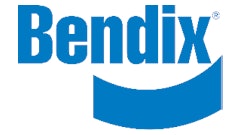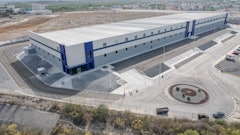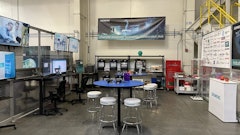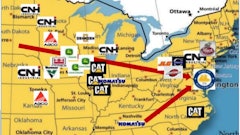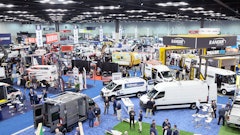Joy Global Inc., has reported its fourth quarter and full year fiscal 2011 results.
Fourth quarter bookings increased 33% to $1.4 billion in fiscal 2011, compared to the fourth quarter of last year. Operating income increased 31% to $296 million on a revenue increase of 27% to $1.3 billion. Income from continuing operations was up 33% to $195 million, or $1.83 per fully diluted share, compared to income from continuing operations of $146 million, or $1.39 per fully diluted share, for last year's fourth quarter. Earnings per share were reduced by $0.07 in the quarter and $0.18 for the full year by acquisition transaction costs and excess purchase accounting attributable to the LeTourneau Technologies, Inc. (LeTourneau) acquisition.
Fourth Quarter and Full Year Highlights
"Our fourth quarter was a good finish to an exceptional year," says Mike Sutherlin, President and Chief Executive Officer. "Bookings were strong as our customers continue to move ahead with mine expansion projects. Sales were up almost 18% from last year and exceptional operating leverage delivered margins of almost 23%, excluding the impact of acquisition related activities."
"The strong fourth quarter performance enabled us to deliver a record year in most categories. Bookings for the year were up over 40%, and allowed us to grow sales by more than 20% and still carry strong backlogs into fiscal 2012. Even after funding this strong growth, we generated $500 million in cash from operations in fiscal 2011. Operating margins for the year were 21%, including all acquisition costs. In fact, margin improvement was essentially the same with or without the acquisition activity, as LeTourneau's five months of reported results all but covered the costs related to all three transactions. This demonstrates the continued operational efficiency of our core businesses, and the positive contribution of the LeTourneau loader product line from day one," says Sutherlin.
Fourth Quarter Operating Results
The 33% increase in fourth quarter bookings included $116 million from LeTourneau. Orders for the core Joy underground and P&H surface mining equipment business increased 22% over the fourth quarter of last year, with original equipment orders up 25% and orders for aftermarket parts and services up 20%.
Original equipment orders were up as mining companies continue to increase production at existing mines and bring new mines on line. The increase in aftermarket orders resulted from a larger operating fleet of equipment, increased mining production volume and more difficult mining conditions. The increase in orders is net of a $59 million reduction in fourth quarter orders due to a stronger U.S. dollar than in the fourth quarter of last year.
Orders for underground original equipment exhibited typical lumpiness, with a 24% decrease from last year's fourth quarter, while the increase in orders for underground aftermarket parts and services was unusually strong at 24%. The decline in original equipment bookings was almost all attributable to the adjustment of beginning backlog for exchange rate movements. The backlog adjustment was particularly significant due to the large amount of underground backlog currently denominated in Australian dollars. Overall, orders for the Joy underground mining machinery business were reduced by 6% due to the unfavorable impact in foreign exchange rates, and were up 3% net of these adjustments. Orders for underground original equipment increased in the United States and Eurasia, but were down in Australia, China and South Africa due to the timing of projects. The increase in aftermarket bookings was strongest in China, Eurasia and the United States.
Bookings for the core P&H business, excluding LeTourneau, were up 49% from the fourth quarter of last year. This increase was reduced by 6% due to unfavorable movement in foreign exchange rates. Although aftermarket orders for surface parts and services were up 16% from last year, the majority of the total increase came from surface original equipment, which more than doubled from the prior year. Original equipment orders for surface equipment were broadly disbursed across geographies and commodities, including the United States, Canada, Latin America, China and Russia, for use in coal, copper, oil sands and gold mining operations.
Excluding LeTourneau, net sales for the fourth quarter of fiscal 2011 increased 18% to $1.2 billion, while original equipment and aftermarket sales were each up 18% over the prior year. Changes in foreign exchange rates increased net sales by $14 million compared to a year ago.
Net sales of underground mining equipment rose 15% in the fourth quarter compared to a year ago. Original equipment shipments were up 15% and aftermarket shipments were up 16% over the prior year fourth quarter. The original equipment sales were driven by higher shipments in Australia, the United States and South Africa. Aftermarket sales were up in all markets.
Net sales of surface mining equipment were up 21% in the fourth quarter. Original equipment sales increased 25% and aftermarket sales were up 19%. The increase in original equipment sales was led by Australia and South America, with aftermarket sales up across all regions.
Excluding the results from the LeTourneau acquisition, the equity earnings associated with the IMM shares owned by the company, and acquisition transaction costs, operating income was $282 million in the fourth quarter of fiscal 2011, compared to $227 million in the fourth quarter of last year. Return on sales was 22.9% in the fourth quarter, compared to 21.6% last year, before these items.
The current quarter results include $22.6 million of operating profit from LeTourneau, which was reduced by $3.2 million of ongoing purchase accounting depreciation and amortization. The fourth quarter fiscal 2011 also includes $5.6 million of excess purchase accounting associated with the write-up of the acquired inventory and backlog of LeTourneau, $6.2 million in acquisition costs related primarily to financing transactions associated with the pending purchase of the remaining shares of IMM, and profit of $3.4 million related to the company's estimated share of IMM profits for the period the company owned the shares.
The increase in operating profit before the acquisition activities was due to higher sales volume, a favorable mix of aftermarket sales, price realization and favorable manufacturing overhead absorption. These items were partially offset by an increase in selling, engineering and administrative expenses.
Net interest expense increased to $11 million in the fourth quarter of 2011 from $4 million in the prior year. The increase in interest expense is attributable to incremental borrowings associated with acquisition financing.
The effective income tax rate was 31.7% in the fourth quarter of fiscal 2011, compared to 34.1% last year. The effective tax rate is net of $2.8 million of discrete tax adjustment charges in the current quarter versus charges of $7 million in the prior year. Excluding these discrete adjustments would result in an effective tax rate of approximately 30.7% in the fourth quarter of fiscal 2011 and 31.1% in the fourth quarter of the prior year. The decrease is due to a mix of geographic earnings and the implementation of tax planning initiatives.
Impact of Unusual Items on Earnings Per Share
Income from continuing operations was $195 million, or $1.83 per fully diluted share, in the fourth quarter of fiscal 2011, compared to income from continuing operations of $146 million, or $1.39 per fully diluted share, in the fourth quarter of the prior year.
Cash generated from continuing operations was $151 million in the fourth quarter of fiscal 2011, compared to cash generated from continuing operations of $211 million a year ago. The decrease in cash generated from continuing operations was due primarily to an increase in inventories to support planned shipments which was partially offset by an increase in accounts payable.
The company purchased $236 million in shares of IMM during the fourth quarter of 2011, bringing its total ownership to 28.1%. The company still awaits approval of the Anti-monopoly Bureau of the Ministry of Commerce (MOFCOM) of the People's Republic of China to complete its acquisition of the 41.1% of the outstanding shares of IMM from an affiliate of The Jordan Company L.P., after which it will commence a mandatory tender offer for the remaining outstanding shares.
During the fourth quarter, the company closed the previously announced sale of LeTourneau's drilling products business to Cameron International Corporation for $375 million, subject to a post closing working capital adjustment.
Capital expenditures were $35 million in the fourth quarter of fiscal 2011, compared to $22 million in the prior year's fourth quarter.
Full Year Fiscal 2011 Operating Results
Fiscal 2011 full year results include LeTourneau operating results for the 19-week period from June 22, 2011 through the end of the fiscal year.
Excluding LeTourneau, bookings for fiscal 2011 increased 41% to $5.5 billion, from $3.9 billion in the prior year. The increase in bookings was led by strong growth in Australia, South America and the United States. Fiscal 2011 bookings include $179 million from the favorable impact of foreign exchange rates.
Total backlog at the end of fiscal 2011 was $3.3 billion, compared to $1.8 billion at the beginning of the fiscal year. The increase reflects a positive book-to-bill ratio during fiscal 2011 plus a $247 million addition of LeTourneau backlog at the time of its acquisition.
Net sales, excluding LeTourneau, increased 21% to $4.3 billion in fiscal 2011, compared to $3.5 billion in the prior year. Original equipment sales increased 18% and aftermarket sales were up 23% for the year. The increases in original equipment sales were led by the United States, South America and Australia, while aftermarket sales were up across all regions.
Excluding the results from the LeTourneau acquisition, the equity earnings associated with the IMM shares owned by the Company, and the acquisition transaction costs, operating profit was $913 million, or 21.4% of sales, for fiscal 2011, compared to $697 million, or 19.8% of sales, in the prior year. The incremental change in operating profit was 29% on the $735 million increase in net sales. The increase in operating profit was attributable to higher sales volume, favorable mix, price realization, and favorable manufacturing overhead absorption. Foreign currency translation favorably impacted operating profit by $19 million in fiscal 2011.
Net interest expense of $24 million in fiscal 2011 increased from net interest expense of $17 million in the prior year, with the increase attributable to acquisition financing. The effective tax rate was 29.6% in fiscal 2011, compared to 32.0% in fiscal 2010. The lower rate was primarily due to a favorable geographic mix of earnings, the implementation of tax planning initiatives, and higher net discrete tax benefits recorded in the current year.
Impact of Unusual Items on Earnings Per Share
Income from continuing operations was $631 million, or $5.92 per fully diluted share, in fiscal 2011, compared to income from continuing operations of $461 million, or $4.40 per fully diluted share, in fiscal 2010.
Cash generated from continuing operations was $500 million in fiscal 2011, a decrease of $83 million from fiscal 2010. The decrease in cash from continuing operations was largely due to increases in inventory and accounts receivable, partially offset by the higher net income and increased customer advance payments. Accounts receivable increased as a result of the higher fiscal 2011 sales volume. Inventories increased in support of planned future shipments and the higher number of machines in the field.
Capital expenditures were $111 million in fiscal 2011, compared to $73 million in fiscal 2010, due to continued investments in global capacity and aftermarket service infrastructure. Capital expenditures for fiscal 2012 are expected to be approximately $200 million.
Market Outlook
Commodity demand is correlated to economic trends, and slowing global growth is tempering the demand for mined commodities. Spot prices for coal, copper and iron ore are down from their highs earlier this year by as much as 20%. However, these numbers need interpretation. First, de-stocking has reduced commodity imports below end-use demand, and set the stage for subsequent re-stocking. China's imports of both copper and coal were reduced earlier this year as stock levels were reduced by rising prices and tightening credit. India's imports of seaborne coal have been similarly reduced, and this has lowered stock levels at power generating plants to the lowest levels in three years. Steel production in China is down over 15% since the summer as trader inventories were forced down by tight credit policies. With better pricing and more constructive credit policies, commodity demand is expected to see improvement from restocking. Secondly, reduced prices will have a greater effect on the higher marginal cost producers. It is estimated that 15% of the combined volume of seaborne and China domestic iron ore has a production cost of $140 per metric tonne or higher. As iron ore spot prices dropped from their highs of $190 per dry metric tonne earlier this year to their lows of $117 in October, high cost producers from China and India were forced out of the market and prices have since stabilized at around $140. The result is a better market for the larger, better capitalized and more efficient mines.
Mining companies generally expect today's sluggish demand to return to strong growth well before the lead time to bring new mine production on line. This view is based on a number of factors. For one, global industrial capacity utilization has remained in the mid-70% range as economies slowed. Conversely, industrial capacity utilization in 2009 dropped below end-use demand to generate cash from inventory reduction. Today's industrial sector inventories remain at historically low levels in days of supply, and inventory reduction is not expected to be an additional drag on commodity demand.
The global mining industry currently operates with little available excess capacity. Although down from earlier peaks, current spot prices for coal, copper and iron ore are up by 50 to 75% over the past two years and provide sufficient returns to justify continued mine expansion by all but the highest cost producers. A positive longer term outlook combined with stronger balance sheets and substantial cash on hand allows mining companies to continue making strategic investment decisions despite near term uncertainty. Miners remain focused on deploying capital expenditures to generate organic growth throughout the cycle. As a result, a number of major mining companies have announced increased capital expenditure budgets for 2012, and they continue to receive Board approvals of major green field projects.
Although the China economy has been slowing, it continues to signal a soft landing. The growth in Gross Domestic Product was 9.1% in the third quarter, which is down only modestly from the 9.7% peak earlier this year. Inflation as measured by the Consumer Price Index was down to 4.2% in November from 5.5%t in October. October saw the fastest growth in Chinese manufacturing output in six months, and there was further improvement in November. Coal imports reached a record level in September and are expected to remain strong for the balance of the year as stockpiles are rebuilt for the winter heating season. China copper consumption should be up 8% this year and could reach 7 million metric tonnes, driving imports to a 17-month high in October. And finally, China's 12th Five Year Plan calls for $840 billion U.S. dollars to be spent on investments in power generation and the electricity grid, and this will add support to long term commodity demand in China.
India has become a significant importer of seaborne coal, and its imports are expected to reach 200 million metric tonnes over the next few years. The government target of 660 million tonnes for coal production this year should easily be missed by more than 100 million tonnes. Coal India, Ltd.'s 8% production decline in the third quarter is part of this miss. As a result, coal stockpiles at power plants are down 30% and power cuts are possible.
In the U.S. coal market, production has mostly been linked to export demand. Exports of U.S. coal are up over 50% from last year, and should reach 100 million tons by year end. This would be the highest volume of exports since 1992, and as a result coal production is up while stockpiles at utilities have declined to 148 million tons. The average price of Central Appalachian coal is up 15% from last year and mining customers are investing in mine and port expansions to increase exports based on the long-term outlook for seaborne demand.
Copper markets continue to be subject to disruptions and long-term declining ore grades, which keeps the market in a supply deficit. Disruptions have become routine and are predictable at 5 to 6% of volume. As a result, copper production should be flat with last year, creating a supply deficit of around 250 thousand tonnes. This should keep copper prices above $3.50 per pound, with significant long term opportunity to the upside. This outlook and long lead time for mine expansion keeps a large number of copper projects in development.
Company Outlook
Although commodity demand is expected to remain sluggish in the near term, any downside should be mitigated by the restocking of commodities and helped by industrial inventories that are already at historically low levels. In addition, demand in the near term could shift to lower cost producers as high marginal cost mines are squeezed out. As a result, the company expects near term production to grow at a more tempered pace until the global economies provide stronger direction. This will affect aftermarket demand, especially if older machines are parked while new machines are commissioned. Customers are expected to continue their investment in strategic projects while they monitor the market trends. Announced customer capital expenditure budgets should be up modestly this year, but the flow-over from 2011 will make actual spend higher. However, a cautionary tone is expected to focus customers on the development of priority projects and on completing existing and planned expansions rather than adding to the pipeline, and this could result in a leveling of original equipment orders if the current macroeconomic conditions persist.
"We expect demand to grow at a more moderate rate in 2012, and our focus will be on long term growth and efficiencies," continues Sutherlin. "In addition to delivery commitments and aftermarket capabilities, we will accelerate our Operational Excellence program while we focus on efficiencies and leverage that will take costs out of overheads and other scalable functions. This will enable us to continue improving margins even with the pressures that will come from a slower market. Consistent with the outlook of current sluggishness leading to the return of strong growth, we will continue to move ahead with our capacity upgrades and expansion plans to meet the long term needs of our customers. As a result, we will increase our capital expenditure budget to $200 million, up from the $150 million we budgeted and the $111 million we actually spent in 2011," says Sutherlin
"Our guidance for 2012 includes the LeTourneau mining business as a product line reported within our P&H surface mining equipment business, but IMM will not be incorporated into our 2012 guidance until after we have completed its acquisition. Any further acquisition costs are also not included in the guidance. With this qualification, we expect our fiscal 2012 revenues to be between $5.3 billion and $5.5 billion. We expect to continue to deliver operating leverage of 25%, and this will translate into earnings per fully diluted share between $7.00 and $7.40. LeTourneau is expected to contribute $400 million to 2012 revenues and $0.41 to earnings per share. This includes $0.15 of purchase accounting charges, of which $0.08 is expected to continue beyond LeTourneau's first year," concludes Sutherlin.





